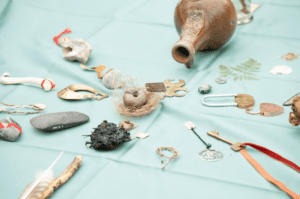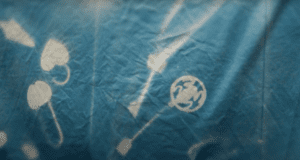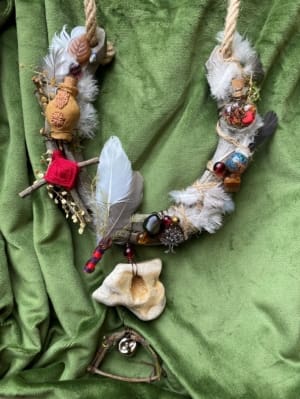Folklore, Spiritually Invested Communities, and the Ethnography Museum
Tom Crowley (Senior Curator, Gunnersbury Park Museum), 11th June 2024.
The relationship between ethnographic museums and ‘folky’ collections from Britain is telling. Whilst many ethnographic museums hold objects from historic British contexts, often they haven’t left the stores to see the light of the display case for generations. A notable exception here is the Pitt Rivers: the museum of a museum. But this is the exception that proves the rule, its displays of British material culture survive as a throwback to the Museum’s founding curatorial vision, established well over a century ago.
The reasons for this banishing of historic British collections from display are twofold: firstly, the early divergence between archaeology, anthropology, and the study of folklore and their emergence as separate disciplines, and secondly, the related reluctance of British anthropologists to turn the ethnographic gaze onto their own culture. From soon after its inception in places like the Pitt Rivers, anthropology developed into the study of the Other, a legacy which it is still grappling with.
Several projects have addressed the divergence between the study folklore and anthropology in the context of ethnographic collections. The Pitt Rivers’ eloquently named The Other Within wound up in 2009 and made a thorough investigation of the Museum’s English collections. In 2011 the Wellcome Collection opened its visually beautiful and moving exhibition A Charmed Life: the Solace of Objects. Curated by the artist Felicity Powell, who was terminally ill at the time, the exhibition displayed hundreds of charms collected by Edward Lovett around a century perilously. Much of what was on display came from London, material evidence of magical practices which rural migrants had brought with them to the city.
When my colleagues and I were planning the Horniman Museum and Gardens’ World Gallery – which opened in 2018 – we drew inspiration from The Other Within and A Charmed Life. The Horniman holds approximately eighty charms collected from rural England around the turn of the twentieth century. In 2014, I invited the Museum of Witchcraft and Magic and contemporary amulet-makers to a workshop looking at how we might display our charms. Then in 2016 we programmed The Magic Late, an event focusing on the same collection. It sold out, with attendees queuing to get a glimpse of the charms. We asked everyone who came to bring in their own personal charms so we could photograph them, and almost everyone brought something. It became very clear to us that a hitherto overlooked part of our collection held a great deal of significance for many of our visitors.
I condensed what we learnt from the workshop and The Magic Late into a display called England: Luck and Protection, which forms part of the World Gallery. It remains the most popular element of the Gallery. Furthermore, videos about the charms on display are the Museum’s most viewed content on TikTok, over half the users of which are under 34. Whilst folklore is often perceived to have a whiff of the archaic and ‘has been’ about it, the appeal of Horniman’s charms suggests a very different story.
Enthusiasm for the Horniman’s English charms correlates with censuses which reveal that faiths and practices like Paganism, Shamanism, Wicca, and witchcraft are rapidly on the rise. With such a huge and potentially very interested audience, it strikes me as a serious missed opportunity that collections of magical material from Britain so often remain hidden away, slumbering deep in museum stores. Nigel Jeffries an expert on early modern witch bottles and an archaeologist at the Museum of London Archaeology (MOLA) feels the same; last year we set about applying for a partnership grant supported by MOLA’s AHRC funded Impact Accelerator Award to bring museum professionals, archaeologists and ‘spiritually invested’ communities together.
In the process we teamed up with some wonderful project partners: Dr Christina Oakley Harrington, the founder of the celebrated esoteric bookshop Treadwell’s and the academic Dr Kirsty Ryder both brought spiritually invested perspectives – and much more – to the project; Sarah-Jane Harknett of the University of Cambridge Museums and the Museum of Archaeology and Anthropology led our approach to evaluation; and Dr Peter Hewitt, founder of the Folklore Museum Network helped us realise the sector-wide impact of the work we were planning.
Soon a co-designed project shaped up that would be based around a series of workshops held at a museum with relevant collections. Worlds which had not in the past always aligned: that of the museum professional, and that of the person who saw spiritual value in the collections, would be brought together; perspectives and knowledge would be shared, and creative outputs would be sought. Museums could learn about the ongoing significance of their collections, and they could learn how to engage new communities. Spiritually invested participants could learn how to work with museums and could draw inspiration from the collections. Creative outputs would demonstrate how these encounters could generate new culture; new manifestations of their collections for museums in turn to draw inspiration from.
We found the perfect museum partners in Faye Belsey and Bryony Smerdon of the Pitt Rivers. In January 2024, they facilitated two days of workshops and discussions at the Museum which brought together researchers and museum staff on the one hand and spiritually invested participants on the other in a roughly 50-50 mix. The first day began with a tour of the galleries where participants considered how magical objects were displayed as well as approaches to design, labelling, and curation. The gallery tour led to fruitful discussions. It was queried, for example, why objects used in ‘counter-witchcraft’ (such as ‘witch bottles’) were kept alongside objects that were used in sacred, ritual, and spiritual practices. This left some participants feeling uncomfortable, and led to conversations about whether the context of the museum could suppress the efficacy of the item; had curation, display and years without use impacted them as magical objects? Further to this, the group pointed out that because the efficacy of magical objects was always described in the past tense – ‘this object was thought to be able to…’ – this suggested to the visitor that no-one would now believe the objects to be possessed of agency.
Later in the day participants spent time looking at how relevant catalogue entries are created and managed, and this led to discussions of how knowledge is recorded and/or excluded. Importantly, catalogues were seen as sites of inspiration: the level of detail in a good catalogue entry, it was observed, could lead to countless possibilities for further research, artistic responses, and spiritual enrichment.

On the second day it was the participants’ turn to lead. Everyone at the workshop spoke about an object of great personal significance to them, thereby creating shared ground across all attendees, independent of their positionality. Then, in a series of brief sessions, spiritually invested participants involved everyone in rituals inspired by objects in the Pitt Rivers’ collection. Here, those of us who did not see ourselves as spiritually invested were learning by doing. Speaking for myself, I found this process surprisingly emotionally effecting.
On the second day creative outputs also began to take shape. In one session we formed a sort of unofficial procession that led up through the Museum onto the roof. There, flanked by faded and tattered prayer flags left by previous visitors, the artist Hanna Katrina Jedrosz had laid out a two-meter square sheet of cyanotype fabric. Onto it, in a preordained pattern, we placed our objects of personal significance as well as objects which had been chosen by participants from the Museum’s collection. The resulting photograph represents an eloquent portrait of the workshop’s second day.

A film crew was also present on the second day as we thought it was important to record the workshops in this way and were mindful that a good quality short video would be a very effective way of sharing the project. The evaluation conducted by Sarah-Jane revealed that several participants found the presence of the crew intrusive although it’s important to note that the participants also acknowledged that the crew were respectful and were as unobtrusive as possible given their brief. Sarah-Jane’s evaluation also found that the Museum and the project organisers didn’t always ‘give sufficient silence and space to allow those they are working with to reflect and respond’ but concluded that ‘the workshop was demonstrably successful at increasing the confidence levels of both creative practitioners and museum professionals’. The evaluation report represents one of the most important project outputs, enabling future initiatives to learn from our mistakes and build on our successes.
In May we officially wrapped up with an evening event at Treadwell’s bookshop. Creative outputs were presented including a wonderful horseshoe charm made by Kirsty which incorporates elements inspired by different facets of the workshops. Faye was so excited by it that with Kirsty’s blessing she took it directly to the Pitt Rivers to join the collection. A wide range of guests were invited to the event from the heritage sector as well as spiritually invested communities. The idea was that the gathering would serve as a means of disseminating the project as well as generating new and fruitful connections between attendees.

A project website which will host or link to all the outputs is currently being developed.
In the meantime you can watch the video of the second day of workshops. Please get in contact with me for a copy of the evaluation report.
I’d like to thank Peter Hewitt for his help in writing this blog post.
‘Amulets, charms, and witch bottles’ is a MOLA Impact Acceleration Account project supported by the Arts and Humanities Research Council (AH/X003523/1)